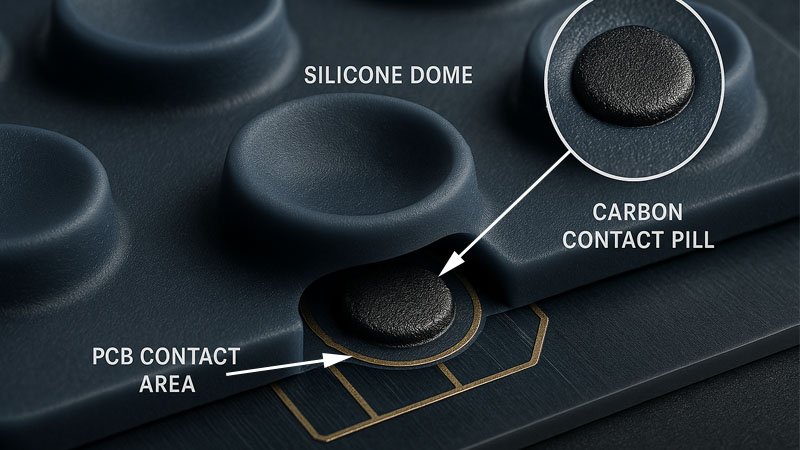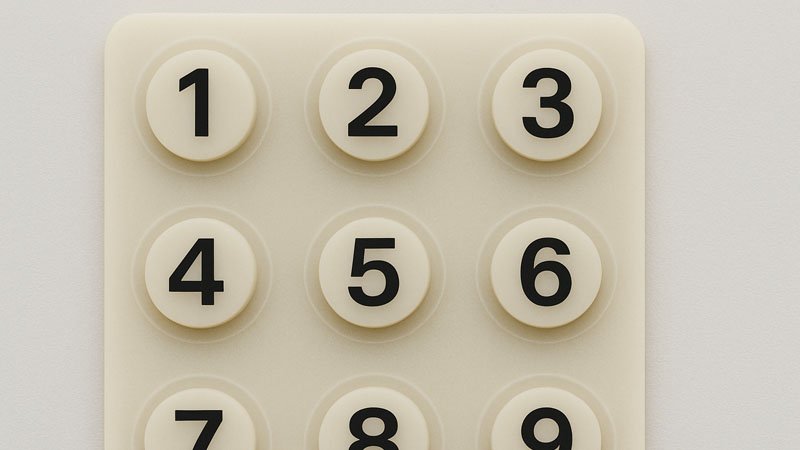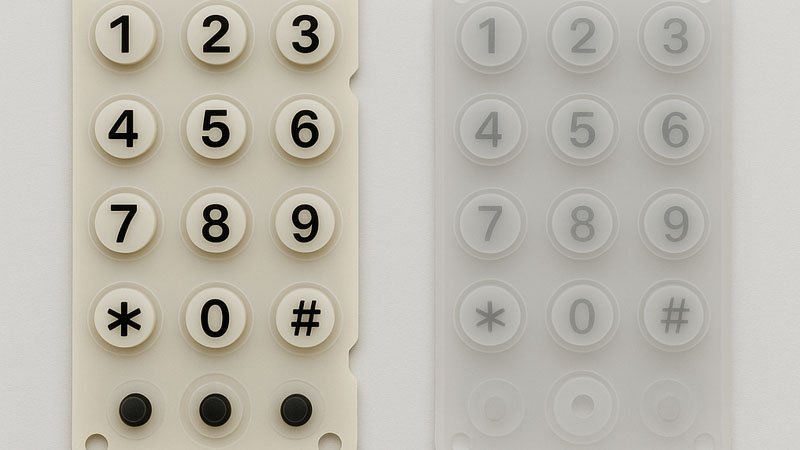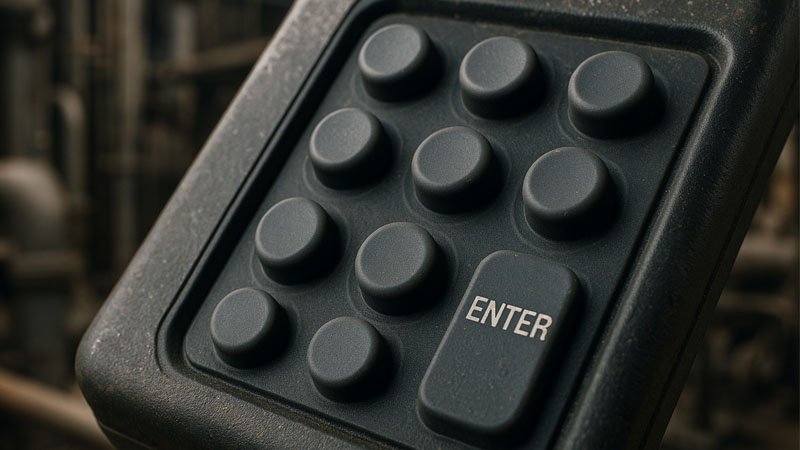Silicone keypads look similar, but what lies beneath can change everything. Choosing the wrong type can ruin your product’s function.
Conductive silicone keypads use carbon or metal pills to close a circuit, while non-conductive keypads rely on mechanical or capacitive input methods. Each type suits different device needs.
Some designs call for precision and responsiveness, while others prioritize durability or aesthetics. I’ve worked on both types across various projects. Let me break down their strengths, weaknesses, and ideal use cases.
What is a Conductive Silicone Keypad?
Silicone keypads often look alike, but conductive ones are all about connection. They’re built to carry electrical signals.
A conductive silicone keypad uses conductive pills—typically carbon or gold—on the bottom of each key to complete an electrical circuit when pressed.

Conductive keypads function like a traditional switch. When a user presses a button, the conductive pill makes contact with the circuit board, closing the loop. These are commonly found in devices like remote controls, medical instruments, and industrial panels where reliable electrical feedback is essential.
There are two main types of conductive materials used: carbon and metal. Carbon is cheaper and provides adequate conductivity. Metal pills like gold or silver offer better durability and lower resistance but come at a higher cost.
Here’s a simple breakdown:
| Material | Cost | Conductivity | Durability | Common Use |
|---|---|---|---|---|
| Carbon | Low | Medium | Medium | Remote controls |
| Gold/Silver | High | High | High | Medical devices |
The main benefit is that they’re easy to integrate with printed circuit boards. But the drawback? They can wear out faster if the pills degrade or if the contacts on the PCB get dirty over time.
What is a Non-Conductive Silicone Keypad?
Sometimes, a circuit connection isn’t needed. Non-conductive keypads serve a different kind of purpose.
Non-conductive silicone keypads don’t contain conductive materials. They function through mechanical feedback or capacitive sensing, depending on the design.

These keypads are usually paired with sensors beneath the surface or used purely for tactile control. For example, in consumer electronics or toys, they’re used for their texture and bounce rather than electrical interaction.
If paired with capacitive sensors, the keypad’s shape and pressure-sensitive areas help guide input detection. If used as mechanical triggers, they interact with a different kind of switch or mechanism under the key.
The big plus? They’re more durable in harsh environments. Since there’s no pill to wear out or contacts to clean, they work well in outdoor equipment or heavy-use products.
Key Differences Between the Two Types?
You can’t treat all silicone keypads the same. Their structure changes how they perform.
The key difference lies in functionality: conductive keypads close circuits, while non-conductive ones do not and rely on external sensors or switches.

Here’s a clear comparison:
| Feature | Conductive Keypads | Non-Conductive Keypads |
|---|---|---|
| Circuit Connection | Yes | No |
| Material on Contact | Carbon/Metal Pills | Plain Silicone |
| Durability | Medium | High |
| Maintenance | Requires contact care | Low maintenance |
| Feedback Type | Tactile + Electric | Tactile or Capacitive |
| Common Devices | Remote, Medical, POS | Toys, Outdoor Panels, Touch |
This difference makes each suited for specific products. If your device needs precise control and electronic input, go conductive. If you want a longer lifespan with no electrical requirement, go non-conductive.
Which is Better for Harsh Environments?
The real world is messy. Dust, moisture, and oils can ruin keypads fast.
Non-conductive silicone keypads are better suited for harsh environments because they have fewer parts that can corrode or fail over time.

Conductive pills can degrade. If moisture sneaks in, it can cause corrosion. That’s why I don’t recommend conductive keypads for outdoor or heavy-duty devices unless they’re fully sealed.
Non-conductive keypads, by contrast, don’t rely on a precise electrical connection. They’re made of solid silicone, which naturally resists water, dust, and temperature extremes. When paired with capacitive sensing or sealed mechanical switches, they last much longer in dirty or damp conditions.
So for applications like outdoor kiosks, fitness trackers, or agricultural tools, I always go non-conductive.
Which Type Offers Better Tactile Feedback?
Not all button presses feel the same. Feedback matters for user experience.
Conductive silicone keypads tend to provide sharper tactile feedback due to their dome shape and pill compression mechanism.

In conductive keypads, the domes are designed to collapse and snap back. This creates a distinct click or resistance that tells the user the button worked. That’s why they’re great for data entry or devices where precision is key.
Non-conductive keypads can also be designed with similar dome structures, but they usually don’t offer the same crisp response. Their strength lies in their customization. You can make them softer or firmer, depending on what’s needed.
Here’s a quick comparison:
| Keypad Type | Feedback Quality | Customization Level |
|---|---|---|
| Conductive | Sharp, Defined | Moderate |
| Non-Conductive | Soft to Medium | High |
For a satisfying click, go conductive. For flexibility and comfort, non-conductive might suit better.
Which One Should You Choose?
It depends on what your product needs. Let’s break it down.
If you need circuit interaction and user feedback, choose conductive keypads. If you prioritize durability and design flexibility, non-conductive ones are a better fit.
When I design products, I always start with the user journey. What will they feel? What’s the function of the key? Then I match the keypad type.
Here’s how I decide:
| Product Type | Recommended Keypad | Reason |
|---|---|---|
| Medical Device | Conductive | Precision, reliability |
| Outdoor Control Panel | Non-Conductive | Weather-resistant, long life |
| Children’s Toy | Non-Conductive | Safe, durable, no small parts |
| Industrial Machine | Conductive (Sealed) | Feedback + control |
| Fitness Tracker Button | Non-Conductive | Sweat-proof, flexible design |
Talk to your supplier. Explain your environment, user type, and feedback needs. It’s not just about conductivity—it’s about the experience.
Conclusion
Conductive keypads offer control and precision. Non-conductive ones offer durability and freedom. The best choice depends on your product’s mission.